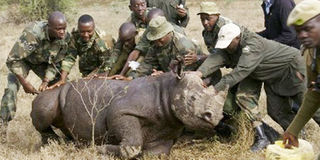Wildlife cropping not in Kenya’s interest

Wardens from KWS prepare a tranquillized black rhino for ear notching at Lake Nakuru National Park. Photo/REUTERS
What you need to know:
- Even in Tanzania, local communities have strongly decried the hunting activities, particularly in Loliondo where a Dubai-based firm, Ortello Business Company, has been organising hunting parties that led to wanton wildlife slaughter.
- Kenya should take heed from the experience of countries that have practised “consumptive utilisation” of wildlife.
The Wildlife Conservation and Management Bill, 2013, introduces wildlife cropping.
Defined in the Bill as the “harvesting of animals for a range of products”, cropping means killing animals and selling their meat, horns and hides. Is this what Kenya wants?
It is interesting to note that those who have exerted pressure to include cropping in the Bill are the same ones who influenced the inclusion of sport-hunting in a 2004 Bill sponsored by Mr G.G. Kariuki, a former Laikipia West MP.
Kenyans also need to know that pressure from large ranch owners led to an experimental cropping programme in 1991 set to initially run for five years. However, because it was so lucrative, it was to continue for 13 long years.
An evaluation done by Tasha Bioservices Ltd established that corruption, mismanagement and abuse of the designated quotas were rampant in the experiment. One of the findings was that the “experiment” had led to rampant poaching for bush meat.
This is because local people did not benefit from the wildlife like their neighbouring ranches which were licensed to crop. Ultimately, the “experiment” was suspended in November 2003.
Furthermore, Kenya should take heed from the experience of countries that have practised “consumptive utilisation” of wildlife. For instance, Zimbabwe implemented the Community Area Management Programme for Indigenous Resources (CAMPFIRE), a hunting programme.
However, it failed to achieve its objective of ensuring that rural communities benefited from the proceeds.
Indeed, University of Zimbabwe scholars found out that in one district, individual households received a measly $1 (Sh87) to $3 (Sh261) in dividends, and that rural district councils retained 50-90 per cent of the revenues.
In West Africa (Nigeria, Ghana, Cote d’Ivoire, Cameroon and Liberia), there is hardly any wildlife left after they allowed consumptive utilisation.
WANTON SLAUGHTER
Even in Tanzania, local communities have strongly decried the hunting activities, particularly in Loliondo where a Dubai-based firm, Ortello Business Company, has been organising hunting parties that led to wanton wildlife slaughter.
With this kind of experience, is it morally right for Kenya to introduce what has led to near extinction of wildlife in other parts of Africa? It is imperative that cropping be removed from the Bill. We have already lost too many animals.
Data from the department of Remote Sensing and Survey indicates that Kenya’s wildlife population has declined by more than 58 per cent in the last two decades. Cropping will definitely worsen the situation.
We also need to ask whether the Kenya Wildlife Service or the other regulatory bodies will have the money, material and manpower to properly regulate cropping. If we have not stopped the poaching of key species like elephants and rhinos, is there any guarantee that cropping will be properly regulated?
Ranchers clamouring for cropping need to remember that a lot of the wildlife they host on their land migrate from national parks and reserves, particularly where ranches happen to be dispersal areas and are not ring-fenced.
In these instances, there is a possibility that 50 per cent (or more) of the animals to be cropped will be from national parks or reserves.
Cropping contradicts all wildlife conservation principles that Kenya has held dear over the years. Let us not compromise our wildlife heritage in search of short-sighted gains.
Mr Ngonyo is the executive director of Africa Network for Animal Welfare and a member of the National Steering Committee that reviewed Wildlife Conservation and Management policy and Act Cap. 376




